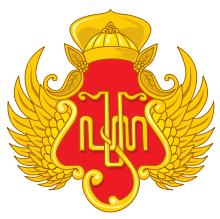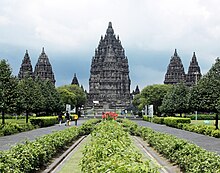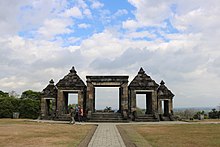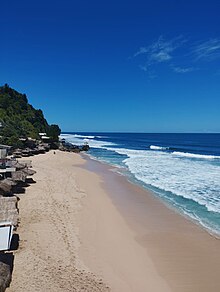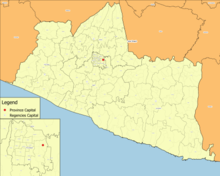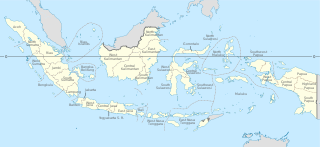
Provinces are the first-level administrative divisions of Indonesia. It is formerly called the first-level provincial region before the Reform era. Provinces have a local government, consisting of a governor and a regional legislative body. The governor and members of local representative bodies are elected by popular vote for five-year terms, but governors can only serve for two terms. Provincial governments have the authority to regulate and manage their own government affairs, subject to the limits of the central government.

Central Java is a province of Indonesia, located in the middle of the island of Java. Its administrative capital is Semarang. It is bordered by West Java in the west, the Indian Ocean and the Special Region of Yogyakarta in the south, East Java in the east, and the Java Sea in the north. It has a total area of 33,750.37 km2, with a population of 36,516,035 at the 2020 Census making it the third-most populous province in both Java and Indonesia after West Java and East Java. The official population estimate in mid-2023 was 37,608,336 The province also includes a number of offshore islands, including the island of Nusakambangan in the south, and the Karimun Jawa Islands in the Java Sea.

Surakarta, known colloquially as Solo, is a major city in Central Java, Indonesia. The 46.72 km2 city adjoins Karanganyar Regency and Boyolali Regency to the north, Karanganyar Regency and Sukoharjo Regency to the east and west, and Sukoharjo Regency to the south. On the eastern side of Solo lies Solo River. Its metropolitan area, consisting of Surakarta City and the surrounding six regencies, was home to 6,837,753 inhabitants according to the official estimates for mid 2023, 526,870 of whom reside in the city proper.
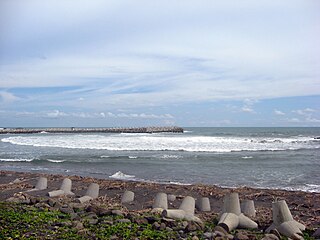
Kulon Progo Regency is one of the four regencies within the Yogyakarta Special Region, Indonesia. It is located on the island of Java. The regency's name stems from the fact that it is situated to the west of the Progo River. The capital is Wates. The greatest part of the population of the regency work as farmers. Kulon Progo Regency is surrounded by the Menoreh Hills. The area of the regency is 577.22 km2, and the population was 388,755 at the 2010 census and 436,395 at the 2020 census; the official estimate as at mid 2022 was 451,342 - comprising 223,328 males and 228,014 females - but the official estimates for mid 2023 revised the population down to 443,053.
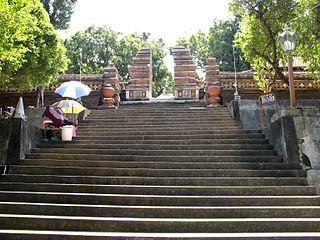
Imogiri is a royal graveyard complex in the Special Region of Yogyakarta, in south-central Java, Indonesia, as well as a subdistrict under the administration of Bantul Regency. Imogiri is a traditional resting place for the royalty of central Java, including many rulers of the Sultanate of Mataram and the current houses of Surakarta and Yogyakarta Sultanate. The name is Imagiri is derived from the Sanskrit Himagiri, which means 'mountain of snow'. The latter is another name for Himalaya.

Tegal is a city in the northwest part of Central Java of Indonesia. It is situated on the north coast of the province of Central Java, about 175 km (109 mi) from Semarang, the capital of the province. It had a population of 239,599 at the 2010 Census and 273,825 at the 2020 Census; the official estimate as of mid-2023 was 262,781.

The Vorstenlanden were four native, princely states on the island of Java in the colonial Dutch East Indies. They were nominally self-governing vassals under suzerainty of the Kingdom of the Netherlands. Their political autonomy however became increasingly constrained by severe treaties and settlements. Two of these continue to exist as a princely territory within the current independent republic of Indonesia.

Bantul is a regency located in the Special Region of Yogyakarta, Indonesia. It is located on the island of Java. The regency's population was 911,503 at the 2010 Census, but has risen to 985,770 at the 2020 Census and to 1,013,170 at the official estimates for mid 2022 - comprising 504,133 males and 509,037 females. Like many regencies on the island of Java, it is densely populated with roughly 1,999 people per square kilometre in 2022, although this is largely because the north of the regency partly surrounds the city of Yogyakarta and contains many suburban communities, notably in the densely-populated districts of Banguntapan, Sewon and Kasihan.

Yogyakarta is the capital city of the Special Region of Yogyakarta in Indonesia, in the south-central part of the island of Java. As the only Indonesian royal city still ruled by a monarchy, Yogyakarta is regarded as an important centre for classical Javanese fine arts and culture such as ballet, batik textiles, drama, literature, music, poetry, silversmithing, visual arts, and wayang puppetry. Renowned as a centre of Indonesian education, Yogyakarta is home to a large student population and dozens of schools and universities, including Gadjah Mada University, the country's largest institute of higher education and one of its most prestigious.
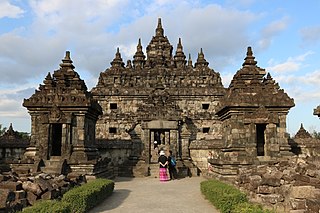
Klaten Regency is a regency in Central Java province in Indonesia. It covers an area of 701.52 km2 and had a population of 1,130,047 at the 2010 Census and 1,260,506 at the 2020 Census; the official estimate as at mid 2023 was 1,284,386. Its administrative centre is in the town of the same name; the town extends over 35.85 km2 to encompass three of the regency's districts, with a combined total of 135,681 inhabitants in mid 2023; a fourth district (Kalikotes) is part of its urban area.

Sleman Regency is an Indonesian regency on the island of Java. It is located in the north of the Yogyakarta Special Administrative Region, Indonesia, and has an area of 574.82 square kilometres (221.94 sq mi), with a population of 1,093,110 at the 2010 Census and 1,125,804 at the 2020 Census; the official estimate as at mid 2022 was 1,147,562 - comprising 569,577 males and 577,985 females. Its capital is the town of Sleman. The current regent is Kustini Sri Purnomo.

Boyolali is a regency in the eastern part of Central Java province in Indonesia. It covers an area of 1,015.10 km2, and had a population of 930,531 at the 2010 census and 1,062,713 at the 2020 census; the official estimate as at mid 2023 was 1,090,131, comprising 547,713 males and 542,416 females. The administrative centre is the town of Boyolali.

Gunungkidul is a regency area located in the Special Province of the Daerah Istimewa Yogyakarta, Indonesia. The capital city is Wonosari City. The name "Gunungkidul" comes from the Javanese language, whose area is located in the Thousand Mountains range of Java Land South side, Special Province Daerah Istimewa Yogyakarta.

Blora is a regency in the northeastern part of Central Java province in Indonesia. Its capital is the town of Blora. The regency is located in the easternmost part of Central Java and borders the Bengawan Solo River and the East Java province. It covers an area of 1,955.83 km2 and it had a population of 829,728 at the 2010 Census and 884,333 at the 2020 Census; the official estimate as of mid-2023 was 901,621, comprising 450,993 males and 450,628 females.

Demak is a regency located in the Indonesian province of Central Java, on the northern coast of the island. It is bordered by Jepara Regency and the Java Sea to the north, Kudus and Grobogan Regencies to the east, Grobogan and Semarang Regencies to the south, while to the west are Semarang Regency and the city of Semarang, to which the districts of Mranggen and Sayung within Demak Regency are essentially suburban. The regency covers an area of 995.32 km2 (384.30 sq mi) and had a population of 1,055,579 at the 2010 Census and 1,203,956 at the 2020 Census; the official estimate as at mid 2023 was 1,240,510. It was originally the centre of the Demak Sultanate, once a dominant power in the region. Due to its strong relation with the spread of Islam in Java and the Wali Sanga, it is sometimes referred to with the nickname Kota Wali.

Grobogan Regency is a regency located in northeastern part of the Central Java province in Indonesia. Created on 4 March 1726, the Grobogan Regency has an area of 2,023.84 km2, and is the second largest regency in the Central Java Province. It had a population of 1,308,696 at the 2010 census and 1,453,526 at the 2020 census; the official estimate as at mid 2023 was 1,514,301. Its capital is the town of Purwodadi.
Wonosari is the administrative centre of Gunungkidul Regency, in the Special Region of Yogyakarta on Java, Indonesia. Wonosari District is bordered to the north by the district of Nglipar, to the east by the districts of Karangmojo and Semanu, to the south by the district of Tanjungsari, and to the west by the districts of Paliyan and Playen. It had a population of 87,454 as of 2020 Census.

TVRI Yogyakarta is a regional television station owned by Televisi Republik Indonesia. It serves the Yogyakarta Special Region, Surakarta Residency in Central Java. This station was the first local television station in Indonesia, founded in 1965. The TVRI Yogyakarta office and studio are located on Jalan Magelang km 4.5, Sleman, and the transmitter is in Patuk, Gunungkidul.

The Special Region of Surakarta was a de-facto provincial-level autonomous region of Indonesia that existed between August 1945 and July 1946. The establishment of this special autonomy status during this period was never established by a separate law based on Article 18 of the original Constitution, but only by a Presidential Determination Charter on 19 August 1945 and Law No. 1 Year 1945 on the Position of the Regional National Committee.
Kartamantul, an acronym of Yogyakarta–Sleman–Bantul, is a metropolitan area in Special Region of Yogyakarta, Indonesia.




